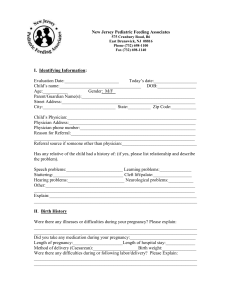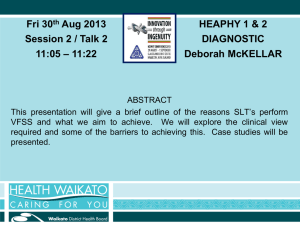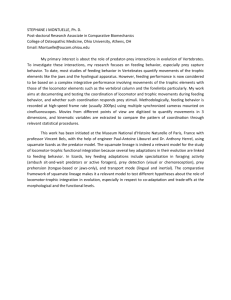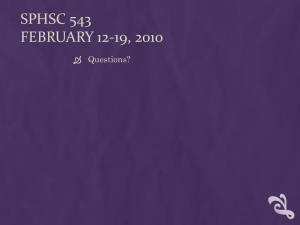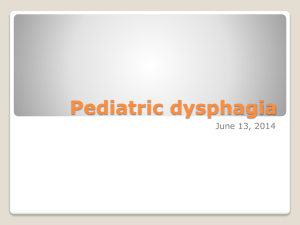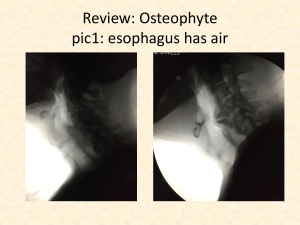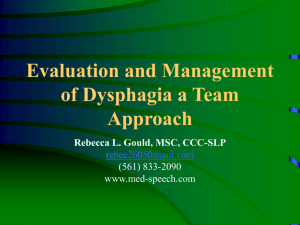CASE #7 (AC) - Northern Speech Services
advertisement
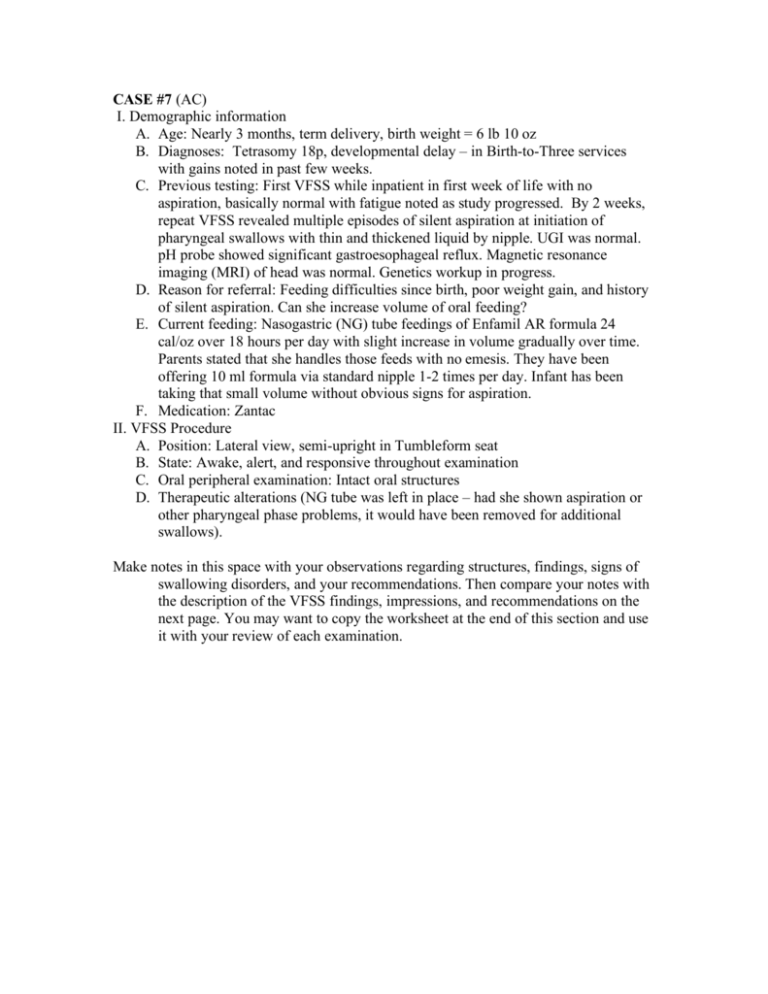
CASE #7 (AC) I. Demographic information A. Age: Nearly 3 months, term delivery, birth weight = 6 lb 10 oz B. Diagnoses: Tetrasomy 18p, developmental delay – in Birth-to-Three services with gains noted in past few weeks. C. Previous testing: First VFSS while inpatient in first week of life with no aspiration, basically normal with fatigue noted as study progressed. By 2 weeks, repeat VFSS revealed multiple episodes of silent aspiration at initiation of pharyngeal swallows with thin and thickened liquid by nipple. UGI was normal. pH probe showed significant gastroesophageal reflux. Magnetic resonance imaging (MRI) of head was normal. Genetics workup in progress. D. Reason for referral: Feeding difficulties since birth, poor weight gain, and history of silent aspiration. Can she increase volume of oral feeding? E. Current feeding: Nasogastric (NG) tube feedings of Enfamil AR formula 24 cal/oz over 18 hours per day with slight increase in volume gradually over time. Parents stated that she handles those feeds with no emesis. They have been offering 10 ml formula via standard nipple 1-2 times per day. Infant has been taking that small volume without obvious signs for aspiration. F. Medication: Zantac II. VFSS Procedure A. Position: Lateral view, semi-upright in Tumbleform seat B. State: Awake, alert, and responsive throughout examination C. Oral peripheral examination: Intact oral structures D. Therapeutic alterations (NG tube was left in place – had she shown aspiration or other pharyngeal phase problems, it would have been removed for additional swallows). Make notes in this space with your observations regarding structures, findings, signs of swallowing disorders, and your recommendations. Then compare your notes with the description of the VFSS findings, impressions, and recommendations on the next page. You may want to copy the worksheet at the end of this section and use it with your review of each examination. III. Findings A. Enfamil AR nectar consistency via standard nipple (presented by father) 1. Variable efficiency - suck:swallow ratio varied from 2-3:1 up to 6:1 2. Once she initiated posterior tongue action in the sucking process, liquid moved through the pharynx with liquid seen only briefly in the valleculae and at times in pyriform sinuses – minimal delay in pharyngeal trigger. 3. Laryngeal penetration just to underside of tip of epiglottis noted occasionally, cleared with completion of the swallow. 4. No aspiration 5. Trace residue in valleculae, pyriform sinuses, and on posterior tongue B. Thin consistency formula via standard nipple 1. Improved efficiency: 1-2 sucks per swallow 2. Less material in valleculae and pyriform sinuses prior to pharyngeal swallow initiation; improved clearance of pharynx 3. Laryngeal penetration to underside of epiglottis more frequent than with thicker liquid; cleared pharynx upon completion of the swallow. 4. Minimal residue in pharynx, cleared with next swallow C. Upper esophageal sphincter opened promptly and adequately, with no difficulty in moving thin and thickened liquid through the UES. IV. Interpretation/Impression A. Gains in recent months re improved sucking strength and coordination of sucking, swallowing, and breathing. No aspiration noted. Gains noted in other developmental domains. Efficiency for regular formula was better than with thickened liquid. Efficiency is important – we don’t want her to expend so much effort sucking and swallowing that she will not take appropriate volume. B. Safe for at least small volume oral nipple feeds, with gradual increase in volume over time. She should not be at obvious risk for aspiration while feeding orally V. Prognosis – Good for total oral feeding adequate to meet nutrition and hydration needs via nipple feeds at least for the next 2-3 months. By 6 months of age or equivalent developmental skill levels, she should be ready for spoon feeding providing gains continue similarly to the past few weeks. VI. Recommendations A. Continue NG tube feeding and oral feeding with thin liquid (maximize nutrition and hydration with liquid that is handled most efficiently). Monitor closely for flow rate to make sure she is efficient, while not getting too much liquid too fast. B. Gradually increase the oral feeding and off set tube feeding in a direct trade-off, per dietitian. C. Mid-line neutral posture is important to minimize risk for aspiration while she drinks thin liquid. D. Continue Birth-to-Three program services. SLP is encouraged to call me at parent request for further information and mutual problem solving. E. I will continue to monitor status for oral sensorimotor skills and feeding with the Feeding Clinic. Further recommendations will be made pending changes in the next few weeks.

